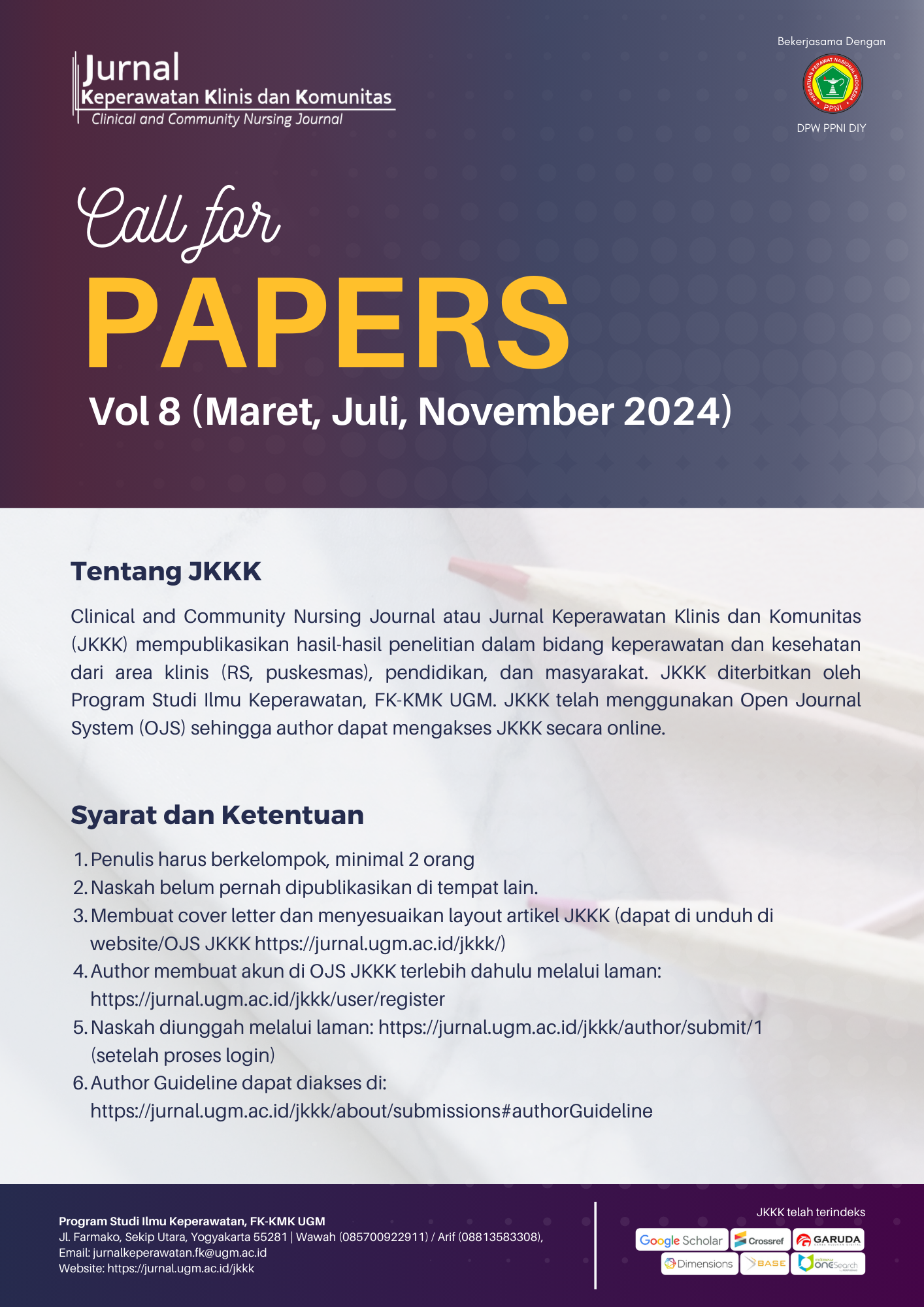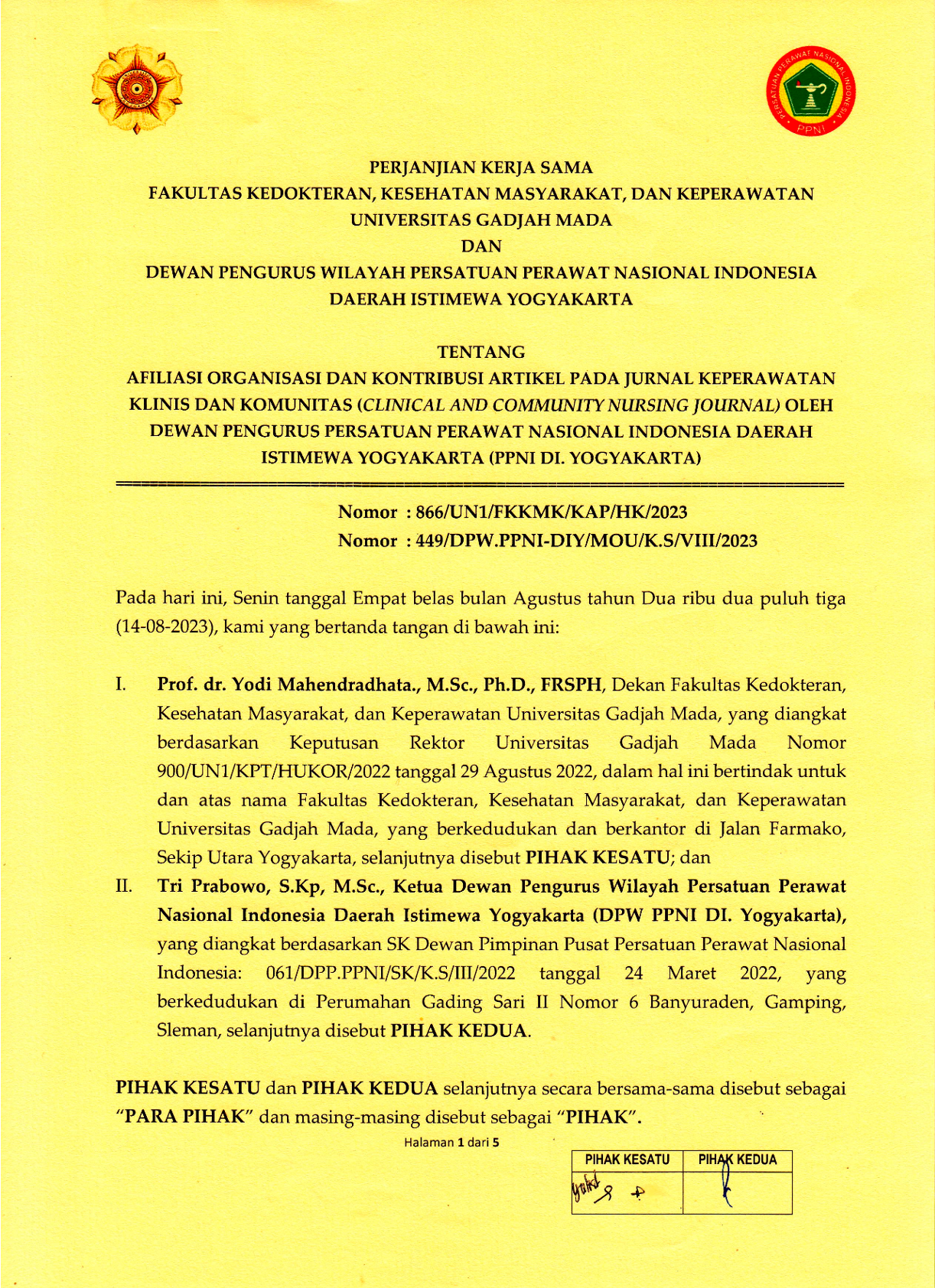Hubungan Pelaksanaan Perawatan Indweling Kateter dengan Kejadian Infkesi Saluran Kemih
Melyza Perdana(1*), Haryani Haryani(2), Khudazi Aulawi(3)
(1) Departemen Keperawatan Medikal Bedah, Fakultas Kedokteran, Universitas Gadjah Mada, Yogyakarta
(2) Departemen Keperawatan Medikal Bedah, Fakultas Kedokteran, Universitas Gadjah Mada, Yogyakarta
(3) Departemen Keperawatan Medikal Bedah, Fakultas Kedokteran, Universitas Gadjah Mada, Yogyakarta
(*) Corresponding Author
Abstract
Background: Nosocomial infection is the most common problem occurs among 9% of 1,4 million hospitalized patients in the world. Urinary tract infections (UTIs) account for up to 40% of nosocomial infections which are reported by acute-care hospitals every year.
Objective: The objective of this study was to identify the association between indwelling catheter care and urinary tract infections in internal ward of Dr. Sardjito Hospital, Yogyakarta.
Methods: This was a non experimental study with cross-sectional design. The subjects of this study were 27 patients who had indwelling catheter inserted in internal ward of Dr. Sardjito Hospital, Yogyakarta chosen by total sampling technique. Data were obtained from checklist that was arranged based on literature and catheter care procedures in Dr. Sardjito Hospital, Yogyakarta.
Results: The results of the study showed that 18 of 27 patients who had indwelling catheter inserted had UTIs. The p value resulted from chi-square test was 0,023 (p<0,05). Statistically, this study showed that there was an association between indwelling catheter care and UTIs. There were some of catheter care procedures that had not well-implemented yet by the nurses, such as daily catheter care procedure (37%), hand washing before and after the procedure (49,4%), using gloves in every catheter contact (39,5%), cleaning the meatus and catheter with antiseptic (40,7%), and ensuring the catheter bag did not touch the oor (18,5%).
Conclusion: There was an association between indwelling catheter care and UTIs in internal ward of Dr. Sardjito Hospital, Yogyakarta.
ABSTRAK
Latar belakang: Infeksi nosokomial merupakan masalah global dan menjangkau sekitar 9% lebih dari 1,4 juta pasien rawat inap di rumah sakit di seluruh dunia. Infeksi saluran kemih merupakan penyebab 40% dari semua infeksi nosokomial yang dilaporkan oleh rumah sakit perawatan akut tiap tahunnya. Kira-kira 10% dari pasien-pasien yang dirawat di rumah sakit terpasang kateter, memberikan populasi besar yang beresiko terhadap infeksi saluran kemih yang berhubungan dengan kateter.
Tujuan: Untuk mengetahui hubungan pelaksanaan perawatan kateter dengan kejadian infeksi saluran kemih di Bangsal Penyakit Dalam RSUP Dr. Sardjito, Yogyakarta.
Metode: Penelitian ini merupakan penelitian non-eksperimental menggunakan rancangan cross sectional. Subjek penelitian ini adalah pasien yang dipasang kateter di Bangsal Penyakit Dalam RSUP Dr. Sardjito, Yogyakarta yang diambil dengan teknik total sampling. Data dikumpulkan dengan menggunakan lembar observasi pelaksanaan perawatan yang disusun berdasarkan prosedur tetap dan dimodi kasi dengan teori yang ada.
Hasil: Hasil penelitian menunjukkan bahwa 18 dari 27 pasien yang diobservasi mengalami infeksi saluran kemih. Dari hasil uji chi square didapatkan nilai p sebesar 0,023 (p<0,05). Secara statistik diketahui bahwa ada hubungan antara pelaksanaan perawatan kateter dengan kejadian infeksi saluran kemih. Belum semua tindakan perawatan kateter dilakukan 100% oleh perawat. Tindakan ini meliputi melakukan perawatan kateter satu kali setiap hari (37%), mencuci tangan sebelum dan sesudah tindakan (49,4%), menggunakan sarung tangan (39,5%), membersihkan daerah meatus dan ujung kateter dekat meatus dengan cairan antiseptik (40,7%), kantung penampung urin tidak menyentuh lantai (18,5%).
Kesimpulan: Ada hubungan antara pelaksanaan perawatan indwelling kateter dengan kejadian infeksi saluran kemih di bangsal penyakit dalam RSUP Dr. Sardjito Yogyakarta.
Keywords
Full Text:
PDFReferences
- Departemen Kesehatan Republik Indonesia. Pedoman pengendalian infeksi nosokomial di rumah sakit. Direktorat Jenderal Pelayanan Medik Spesialistik, Jakarta.1999.
- Chavez GF, Delahanty KM, Cahill C, Eck E, Graham J, LaBouyer B, McDonald M, Mendelsohn M, Oriola S, and Rosenberg, J. Recommendations to reducing morbidity and mortality related to health care associated infections in California, healthcare associated infections advisory working group. Final report to the California departement of health services. California. Available on: http://who. com/sea-nurs-kars.php. Tanggal up date: 25 April 2007. 3
- Singodimedjo P. Peran kateter uretra pada infeksi saluran kencing (nosokomial) di rumah sakit. 1998.
- Tew L, Pomfret I, King D. Infections risk assosiated with urinary catheters. Nursing Standard, United Kingdom.2005.
- Schaffer SD, Garzon LS, Heroux, DL and Korniewicz, DM. Infection prevention and safe practice. ISBN 0815175930. Mosby, St. Louis.1996.
- Suhardi DA. Infeksi saluran kemih yang berkaitan dengan pemakaian kateter. Laporan penelitian. Universitas Gadjah Mada, Yogyakarta. 1998.
- Sarim ES. Usaha menurunkan angka bakteriuria setelah pemasangan kateter uretra menetap dan perawatan terbuka dengan pemakaian salep poviodone iodine. UPF Ilmu Bedah FK UNPAD/ RS. Hasan Sadikin, Bandung. 1987.
- Evaluasi biakan urin pada penderita BPH setelah pemasangan kateter uretra menetap:pertama kali dan berulang. 1999.
- Smeltzer SC, and Bare BG. Brunner and Suddarth’s text book of medical surgical nursing. Alih bahasa H.Y. Kuncara, Andry Hartono, Monica Ester, Yasmin Asih, EGC, Jakarta.2002;8(2).
- Insidensi infeksi nosokomial saluran kemih akibat kateterisasi urin di IRNA Bedah Kelas II RSUP Dr. Mohammad Hoesin Palembang. Skripsi. PSIK FK UGM, Yogyakarta.2007.
- Insidensi infeksi saluran kemih pada pasien yang terpasang kateter di IRNA V Paviliun Cendrawasih di RSUD Dr Sardjito. Skripsi. PSIK FK UGM, Yogyakarta. 2004.
- Karina Billote-Domingo MD, Myrna T, Mendoza MD, Tessa Tan Torres, MD. Catheter-related urinary tract infections: incidence, risk factors and microbiologic profle.1998.
- Mangnall J, Watterson L. Principles of aseptic technique in urinary catheterisation. Nursing Standard, United Kingdom. 2006;21(8).
- Head, C. Insertion of urinary catheter. Nursing older people. United Kingdom.2006;18(10).
- Nicolle, LE. Catheter-related urinary tract infection. Drugs aging. Journal Departemens of Internal Medicine and Medical Microbiology, University of Manitoba. Canada.2005.
- Purnomo BB. Dasar-dasar urologi. Sagung Seto, Jakarta.
- Timby BK, Scherer JC, Smith NE. Introductory medical surgical nursing seventh edition. Lippincott, Philadelphia.1999.
- Rosner F. Hand washing and infection control. Journal of Medicine. 2007;74.
- Corona, A and Raimondi, F. Prevention of nosocomial infection in ICU setting. Minerva Anastesiol.2004;70(329).
- Potter PA dan Perry AG. Buku ajar fundamental keperawatan: konsep, proses dan praktik. Alih bahasa Renata Komalasari, Dian Evriyani, Enie Noviastari, Alfrina Hany, sari Kurnianingsih, EGC, Jakarta.2005. Edisi 4 Volume 2.
- Girou E, Loyeau S, Legrand P, Oppein F, Brun-Buissonc. Effcacy of Handrubbing with alcohol based solution versus standard hand washing with antiseptic: Randomized clinical trial. BMJ.2002: 325(7360):362-6.
- National Health Care. Best practice statement June 2004 urinary catheterisation & catheter care. Journal EBSCO, USA.2004.
- Evaluasi pelaksanaan perawatan kateter uretra menetap di Ruang Rawat Inap Bedah B2 RSUD Dr. Sardjito. Skripsi. PSIK FK UGM, Yogyakarta.1999.
- Tatik H. Faktor-faktor yang mempengaruhi perawat dalam pelaksanaan protap pemasangan dan dressing kateter uretra di Bangsal Rawat Inap RSUP Dr. Soeradji Tirtonegoro Klaten. Skripsi. Universitas Gadjah Mada, Yogyakarta.2005
Article Metrics
Refbacks
- There are currently no refbacks.
Copyright (c) 2017 Melyza Perdana, Haryani, Khudazi Aulawi

Jurnal Keperawatan Klinis dan Komunitas (Clinical and Community Nursing Journal)
collaborates with DPW PPNI DIY
![]()
Jurnal Keperawatan Klinis dan Komunitas (Clinical and Community Nursing Journal) is licensed under a Creative Commons Attribution-ShareAlike 4.0 International License.





